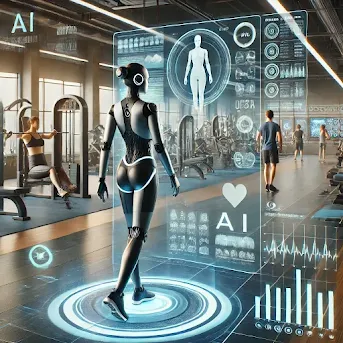AI-Powered Fitness: Personalized Workouts and Health Monitoring
- Get link
- X
- Other Apps
AI-Powered Fitness: Personalized Workouts and Health Monitoring
Introduction
Artificial Intelligence (AI) is transforming the fitness industry, offering personalized workout plans, real-time health monitoring, and data-driven insights that enhance physical well-being. AI-driven fitness solutions leverage advanced algorithms, machine learning, and wearable technology to create tailored exercise programs, optimize performance, and promote healthier lifestyles. In this article, we explore how AI is revolutionizing fitness, the benefits it offers, potential challenges, and the future of AI-powered health solutions.
The Role of AI in Fitness and Health
Personalized Workout Plans
AI-powered fitness apps analyze user data, including age, weight, fitness level, and exercise preferences, to create customized workout routines. These plans adjust dynamically based on progress, performance, and goals.
Example: Apps like Freeletics and Fitbod use AI to generate workouts based on user feedback and previous training sessions.
Impact: Personalized training programs enhance motivation, reduce the risk of injury, and optimize fitness results.
Real-Time Health Monitoring
Wearable devices powered by AI track vital health metrics such as heart rate, oxygen levels, and calorie expenditure.
Example: Devices like Apple Watch and Fitbit use AI-driven analytics to monitor users' activity levels and suggest fitness improvements.
Impact: Continuous monitoring helps detect early signs of health issues, enabling users to take preventive measures.
AI-Powered Virtual Trainers
AI-driven virtual trainers provide real-time feedback, correcting posture, technique, and intensity during workouts.
Example: Apps like Tempo and Peloton use AI-enhanced motion tracking to analyze user movements and provide instant feedback.
Impact: Users receive professional-level guidance without needing in-person trainers, making fitness accessible and affordable.
 |
| An AI-powered smart fitness trainer analyzing user movements and suggesting personalized workout improvements. |
Benefits of AI in Fitness
1. Enhanced User Experience
AI adapts workouts based on user progress, preventing repetitive routines and keeping exercises engaging.
2. Data-Driven Performance Optimization
Machine learning algorithms analyze training patterns, suggest improvements, and predict optimal workout intensities.
3. Motivation and Engagement
AI-powered gamification, including challenges and rewards, keeps users motivated and committed to their fitness goals.
4. Health Risk Detection
AI can identify irregularities in heart rate and other health indicators, alerting users to potential health concerns before they become serious.
5. Accessibility and Inclusivity
AI fitness solutions cater to people of all ages and abilities, offering modified workouts for individuals with physical limitations.
| A futuristic AI-driven health monitoring system tracking real-time fitness metrics on a smartwatch and smart gym equipment. |
Challenges and Considerations
1. Data Privacy and Security
AI fitness apps collect sensitive user data, raising concerns about privacy and data protection.
Solution: Companies must implement robust encryption and comply with data protection regulations such as GDPR and HIPAA.
2. Accuracy of AI Recommendations
AI algorithms must be trained on diverse datasets to ensure reliable recommendations across different demographics.
Solution: Continuous improvement through AI training with diverse user data ensures accuracy and inclusivity.
3. Dependence on Technology
Excessive reliance on AI-driven fitness tools may reduce human engagement in physical training.
Solution: A hybrid approach combining AI insights with human coaching ensures a balanced fitness experience.
The Future of AI in Fitness
AI-Driven Smart Gyms
AI-powered fitness centers will offer personalized workout stations that adjust resistance and intensity based on real-time biometric feedback.
Advanced Health Diagnostics
AI will integrate with medical databases to provide real-time insights into injury prevention, rehabilitation, and chronic disease management.
AI-Powered Nutrition Assistance
AI will analyze dietary habits, suggest meal plans, and track nutritional intake to complement personalized workout programs.
Conclusion
AI is reshaping the fitness industry by providing customized workout plans, real-time health monitoring, and data-driven performance insights. While challenges such as data privacy and AI accuracy remain, continuous advancements in technology promise a future where AI-powered fitness solutions will become an essential part of healthier living. As AI evolves, it will further bridge the gap between technology and human wellness, making fitness more accessible, effective, and engaging.
References
Harvard Health Publishing - How AI is Changing the Fitness Industry: harvard.edu
National Institutes of Health (NIH) - AI and Personalized Fitness: nih.gov
MIT Technology Review - Wearable Tech and AI in Health: technologyreview.com
Forbes - AI in Fitness and Wellness: forbes.com
Stanford AI Lab - The Role of AI in Personalized Health Monitoring: stanford.edu
- Get link
- X
- Other Apps




Comments
Post a Comment